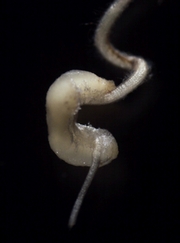August 19, 2013
NIAS Identifies How Legume Protein NIN Works, May Contribute to Cutting Nitrogen Fertilizers
Keywords: Environmental Technology Food University / Research institute

Root nodule formed by inducing
the function of nodule inception (NIN)
Copyright National Institute
of Agrobiological Sciences
The National Institute of Agrobiological Sciences (NIAS) in Japan announced on March 19, 2013, that it has determined the function of nodule inception (NIN), a protein that plays a key role in the formation of root nodules, which legumes require to use nitrogen gas from the atmosphere. The finding is expected to reduce the amount of fertilizers used when growing soybeans and other legumes.
As their roots are infected with rhizobia in the soil, legumes produce root nodules, establishing endosymbiosis with the nitrogen-fixing bacteria in order to use nitrogen gas from the atmosphere as a nutrient source. Research projects on root nodule formation have discovered 12 proteins associated with their formation. While many of these proteins are found in rice, NIN is only found in legumes.
NIAS has confirmed that NIN works to promote the production of NF-Y, a protein that is thought to regulate cell division in animals and yeasts, in order to induce the formation of root nodules.
As root nodule formation can be regulated by adjusting NIN activity, it is expected that the amount of nitrogen fertilizer used for growing soybeans could be reduced if soybeans are stimulated to produce root nodules when needed. The research team is planning to introduce the NIN gene into rice and other key crops to determine whether root nodules can be formed.
Related
"JFS Newsletter"
- Fifth Contest to Award Excellent Environmental and Social Practices by Junior High, High School Students
- Coco Farm & Winery: An Amazing Model of Special Needs Students and Community
- Locally Produced Food in School Lunches----A Challenge by Nyuzen, Japan
- Seikatsu Club: Japanese Cooperative Managed by Members' Will to Confront Social Problems
- Increase Revenues without Increasing Catches -- How the Sustainable Sakura Shrimp Fishery in Suruga Bay Does It
Related
"Popular Articles"
- Yukiguni Maitake and Grameen Group Launching Joint Mung Bean Project in Bangladesh
- Japan's Food Self-Sufficiency Ratio Unchanged at 40% for 8 Years
- Food Pictograms Used at APEC SME Summit 2010
- Rental Organic Farm Provides Farmland for Housing Development Project
- Greenpeace Survey Ranks Five Top Japanese Supermarket Chains for Fish Safety, Finds Problems


